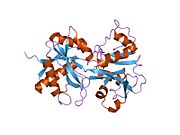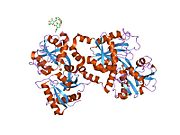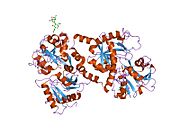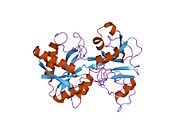Lactoferrin
Ensembl | |||||||||
|---|---|---|---|---|---|---|---|---|---|
| UniProt | |||||||||
| RefSeq (mRNA) | |||||||||
| RefSeq (protein) | |||||||||
| Location (UCSC) | Chr 3: 46.44 – 46.49 Mb | Chr 9: 110.85 – 110.87 Mb | |||||||
| PubMed search | [3] | [4] | |||||||
| View/Edit Human | View/Edit Mouse |
Lactoferrin (LF), also known as lactotransferrin (LTF), is a multifunctional
Lactoferrin is one of the components of the
Lactoferrin supplements reduce the risk of respiratory tract infections, based on a recent meta-analysis of randomized controlled trials.[9] As with any supplements sold online, quality may be an issue because nutritional supplement production quality controls are not subject to the same strict regulatory process as medicines.[10]
History
Occurrence of iron-containing red protein in bovine milk was reported as early as in 1939;
Structure
Genes of lactoferrin
At least 60 gene sequences of lactoferrin have been characterized in 11 species of mammals.
In humans, lactoferrin gene LTF is located on the third chromosome in the locus 3q21-q23. In oxen, the coding sequence consists of 17 exons and has a length of about 34,500 nucleotide pairs. Exons of the lactoferrin gene in oxen have a similar size to the exons of other genes of the transferrin family, whereas the sizes of introns differ within the family. Similarity in the size of exons and their distribution in the domains of the protein molecule indicates that the evolutionary development of lactoferrin gene occurred by duplication.[16] Study of polymorphism of genes that encode lactoferrin helps selecting livestock breeds that are resistant to mastitis.[17]
Molecular structure
Lactoferrin is one of the transferrin proteins that transfer iron to the cells and control the level of free iron in the blood and external secretions. It is present in the milk of humans and other mammals,[13] in the blood plasma and neutrophils and is one of the major proteins of virtually all exocrine secretions of mammals, such as saliva, bile, tears and pancreas.[18] Concentration of lactoferrin in the milk varies from 7 g/L in the colostrum to 1 g/L in mature milk.[citation needed][clarification needed]
Lactoferrin belongs to the basic proteins, its isoelectric point is 8.7. It exists in two forms: iron-rich hololactoferrin and iron-free apolactoferrin. Their tertiary structures are different; apolactoferrin is characterized by "open" conformation of the N-lobe and the "closed" conformation of the C-lobe, and both lobes are closed in the hololactoferrin.[22]
Each lactoferrin molecule can reversibly bind two ions of iron, zinc, copper or other metals.[23] The binding sites are localized in each of the two protein globules. There, each ion is bonded with six ligands: four from the polypeptide chain (two tyrosine residues, one histidine residue and one aspartic acid residue) and two from carbonate or bicarbonate ions.
Lactoferrin forms a reddish complex with iron; its affinity for iron is 300 times higher than that of
Polymeric forms
Both in blood plasma and in secretory fluids lactoferrin can exist in different polymeric forms ranging from monomers to tetramers. Lactoferrin tends to polymerize both in vitro and in vivo, especially at high concentrations.[25] Several authors found that the dominant form of lactoferrin in physiological conditions is a tetramer, with the monomer:tetramer ratio of 1:4 at the protein concentrations of 10−5 M.[27][28][29]
It is suggested that the oligomer state of lactoferrin is determined by its concentration and that polymerization of lactoferrin is strongly affected by the presence of Ca2+ ions. In particular, monomers were dominant at concentrations below 10−10−10−11 M in the presence of Ca2+, but they converted into tetramers at lactoferrin concentrations above 10−9−10−10 M.[27][30] Titer of lactoferrin in the blood corresponds to this particular "transition concentration" and thus lactoferrin in the blood should be presented both as a monomer and tetramer. Many functional properties of lactoferrin depend on its oligomeric state. In particular, monomeric, but not tetrameric lactoferrin can strongly bind to DNA.
Function
Lactoferrin belongs to the innate immune system. Apart from its main biological function, namely binding and transport of iron ions, lactoferrin also has antibacterial, antiviral, antiparasitic, catalytic, anti-cancer, and anti-allergic functions and properties.[31]
Enzymatic activity of lactoferrin
Lactoferrin hydrolyzes
Lactoferrin receptor
The
Bone activity
Ribonuclease-enriched lactoferrin has been used to examine how lactoferrin affects bone. Lactoferrin has shown to have positive effects on bone turnover. It has aided in decreasing bone resorption and increasing bone formation. This was indicated by a decrease in the levels of two bone resorption markers (deoxypyridinoline and N-telopeptide) and an increase in the levels two bone formation markers (osteocalcin and alkaline phosphatase).[36] It has reduced osteoclast formation, which signifies a decrease in pro-inflammatory responses and an increase in anti-inflammatory responses [37] which indicates a reduction in bone resorption as well.
Interaction with nucleic acids
One of the important properties of lactoferrin is its ability to bind with nucleic acids. The fraction of protein extracted from milk, contains 3.3% RNA,[27] but, the protein preferably binds to double-stranded DNA rather than single-stranded DNA. The ability of lactoferrin to bind DNA is used for its isolation and purification using affinity chromatography with columns containing immobilized DNA-containing sorbents, such as agarose with the immobilized single-stranded DNA.[38]
Clinical significance

Antibacterial activity
Lactoferrin's primary role is to sequester free iron, and in doing so remove essential substrate required for bacterial growth.[40] Antibacterial action of lactoferrin is also explained by the presence of specific receptors on the cell surface of microorganisms. Lactoferrin binds to lipopolysaccharide of bacterial walls, and the oxidized iron part of the lactoferrin oxidizes bacteria via formation of peroxides. This affects the membrane permeability and results in the cell breakdown (lysis).[40]
Although lactoferrin also has other antibacterial mechanisms not related to iron, such as stimulation of phagocytosis,[41] the interaction with the outer bacterial membrane described above is the most dominant and most studied.[42] Lactoferrin not only disrupts the membrane, but even penetrates into the cell. Its binding to the bacteria wall is associated with the specific peptide lactoferricin, which is located at the N-lobe of lactoferrin and is produced by in vitro cleavage of lactoferrin with another protein, trypsin.[43][44] A mechanism of the antimicrobial action of lactoferrin has been reported as lactoferrin targets H+-ATPase and interferes with proton translocation in the cell membrane, resulting in a lethal effect in vitro.[45]
Lactoferrin prevents the attachment of
Antiviral activity
Lactoferrin in sufficient strength acts on a wide range of human and animal viruses based on DNA and RNA
The most studied mechanism of antiviral activity of lactoferrin is its diversion of virus particles from the target cells. Many viruses tend to bind to the lipoproteins of the cell membranes and then penetrate into the cell.[54] Lactoferrin binds to the same lipoproteins thereby repelling the virus particles. Iron-free apolactoferrin is more efficient in this function than hololactoferrin; and lactoferricin, which is responsible for antimicrobial properties of lactoferrin, shows almost no antiviral activity.[47]
Beside interacting with the cell membrane, lactoferrin also directly binds to viral particles, such as the hepatitis viruses.[54] This mechanism is also confirmed by the antiviral activity of lactoferrin against rotaviruses,[44] which act on different cell types.
Lactoferrin also suppresses virus replication after the virus penetrated into the cell.
Antifungal activity
Lactoferrin and lactoferricin inhibit in vitro growth of Trichophyton mentagrophytes, which are responsible for several skin diseases such as
Administration of lactoferrin through drinking water to mice with weakened immune systems and symptoms of
Anticarcinogenic activity
The
Cystic fibrosis
The human lung and saliva contain a wide range of antimicrobial compound including lactoperoxidase system, producing
Necrotizing enterocolitis
Low quality evidence suggests that oral lactoferrin supplementation with or without the addition of a probiotic may decrease late onset of sepsis and necrotizing enterocolitis (stage II or III) in preterm infants with no adverse effects.[79]
In diagnosis
Lactoferrin levels in tear fluid have been shown to decrease in dry eye diseases such as
Technology
Extraction
Bovine lactoferrin can be isolated from raw milk, colostrum, or
Nanotechnology
Lactotransferrin has been used in the synthesis of fluorescent gold quantum clusters, which has potential applications in nanotechnology.[83]
See also
References
- ^ a b c GRCh38: Ensembl release 89: ENSG00000012223 – Ensembl, May 2017
- ^ a b c GRCm38: Ensembl release 89: ENSMUSG00000032496 – Ensembl, May 2017
- ^ "Human PubMed Reference:". National Center for Biotechnology Information, U.S. National Library of Medicine.
- ^ "Mouse PubMed Reference:". National Center for Biotechnology Information, U.S. National Library of Medicine.
- ^ PMID 1599309.
- PMID 37059920.
- ISBN 978-0-8247-5329-0.
- ISBN 978-90-5702-292-0.
- S2CID 238475090.
- ^ "Lactoferrin supplements could aid in the recovery of COVID19 & other Respiratory Tract Infections". EurekAlert!. Retrieved 2022-02-18.
- ^ M. Sorensen and S. P. L. Sorensen, Compf. rend. trav. lab. Carlsberg (1939) 23, 55, cited by Groves (1960)
- .
- ^ .
- ISBN 978-0-8493-0909-0.
- ^ S2CID 952135.
- PMID 8206385.
- PMID 18554515.
- PMID 3858982.
- ISBN 978-0-444-50317-6.
- S2CID 218464085.
- PMID 7644538.
- PMID 10089508.
- PMID 7672721.
- PMID 6770907.
- ^ ISBN 978-0-471-92150-9.
- PMID 1581301.
- ^ PMID 6274982.
- PMID 6979357.
- PMID 7762423.
- PMID 2754391.
- .
- S2CID 4160337.
- S2CID 4216981.
- PMID 17766154.
- PMID 22292499.
- S2CID 10711802.
- S2CID 3180066.
- PMID 3827843.
- PMID 7672721.
- ^ PMID 14568385.
- S2CID 46828227.
- S2CID 30937106.
- PMID 9588189.
- ^ S2CID 25875928.
- PMID 20625147.
- ISBN 978-0-9788205-3-4.
- ^ PMID 11675140.
- S2CID 4396295.
- ^ PMID 11908636.
- PMID 35056558.
- PMID 7622881.
- ^ PMID 9785469.
- S2CID 7732075.
- ^ PMID 12522210.
- PMID 11750941.
- PMID 24606707.
- PMID 32738305.
- PMID 33199997.
- PMID 34413211.
- PMID 34575388.
- PMID 15655079.
- PMID 11020258.
- ^ PMID 12499200.
- ^ PMID 15047526.
- PMID 12878528.
- PMID 11089630.
- PMID 10543740.
- PMID 18710913.
- PMID 11908637.
- ^ PMID 16928475.
- PMID 17082494.
- S2CID 4372096.
- S2CID 4423528.
- PMID 15346334.
- PMID 15793153.
- PMID 16503962.
- ^ "Public summary of positive opinion for orphan designation of hypothiocyanite/lactoferrin for the treatment of cystic fibrosis" (PDF). Pre-authorisation Evaluation of Medicines for Human Use. European Medicines Agency. 2009-09-07. Archived from the original (PDF) on 2010-05-30. Retrieved 2010-01-23.
- ^ "Meveol: orphan drug status granted by the FDA for the treatment of cystic fibrosis". United States Food and Drug Administration. 2009-11-05. Archived from the original on 2009-12-24. Retrieved 2010-01-23.
- PMID 32232984.
- PMID 12888052.
- PMID 21910436.
- .
- PMID 20882247.
External links
- Uniprot
- LTF on the National Center for Biotechnology Information
- FDA Lactoferrin Considered Safe to Fight E. Coli.
























